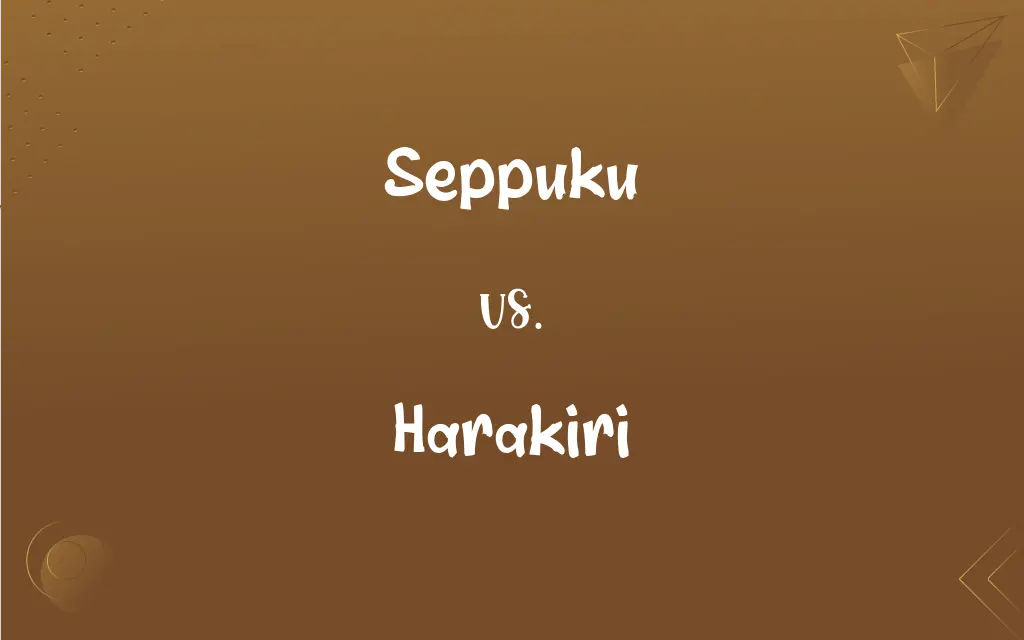Seppuku vs. Harakiri: What's the Difference?
By Janet White & Aimie Carlson || Updated on May 21, 2024
Seppuku is a formal, ritualistic suicide by disembowelment in Japanese culture, often associated with samurai honor, whereas harakiri is a more casual term for the same act, used in everyday language.

Key Differences
Seppuku is a highly ritualized form of suicide by disembowelment in Japanese culture, historically practiced by samurai to restore or maintain honor. It involves a detailed ceremony, including the presence of a second (kaishakunin) who assists in the act to ensure a swift death. Harakiri, while referring to the same act of disembowelment, is a more colloquial term used in everyday language without the formal and ceremonial connotations associated with seppuku.
Seppuku is deeply rooted in the samurai code of Bushido, emphasizing honor, courage, and loyalty. The process is elaborate, involving specific attire, a carefully chosen location, and a final act of writing a death poem. Harakiri, on the other hand, lacks these ritualistic elements and is simply a straightforward term describing the physical act of disembowelment.
While seppuku was often performed as a means to atone for failure or disgrace, adhering strictly to cultural and ethical codes, harakiri does not imply such a strict adherence to ritual or cultural codes. It is more a general reference to the act itself rather than the intricate cultural and moral implications.
Seppuku also included specific roles for witnesses and the kaishakunin, who was responsible for decapitating the individual to end their suffering after the disembowelment. In contrast, harakiri, when used in conversation, does not typically reference these additional roles or the ceremonial aspects.
Seppuku carried significant social and historical weight, being an act of ultimate sacrifice respected within Japanese society. In comparison, harakiri, while understood to mean the same act, does not evoke the same level of solemn respect or historical depth.
ADVERTISEMENT
Comparison Chart
Formality
Highly formal and ritualistic
More casual and colloquial
Cultural Significance
Deeply tied to samurai honor and Bushido
General term with less formality
Ceremony
Involves a detailed, specific ritual
No specific ceremonial elements
Roles Involved
Includes roles like kaishakunin and witnesses
No additional roles specified
Social Perception
Seen as an honorable, respected act
Less solemn, more descriptive term
ADVERTISEMENT
Seppuku and Harakiri Definitions
Seppuku
A ceremonial act to maintain or restore honor.
In feudal Japan, seppuku was often performed as a form of atonement.
Harakiri
A general reference to the act itself.
The historical text mentioned harakiri without detailing the ritual.
Seppuku
Involves a second person (kaishakunin) for decapitation.
The samurai's friend acted as his kaishakunin during seppuku.
Harakiri
Less formal, lacking ritualistic connotations.
Harakiri doesn't convey the ceremonial aspects of seppuku.
Seppuku
A ritualistic suicide by disembowelment practiced by samurai.
The disgraced samurai committed seppuku to restore his honor.
Harakiri
A term for suicide by disembowelment.
He referred to the act as harakiri, using the more casual term.
Seppuku
Includes the writing of a death poem.
Before committing seppuku, he composed a poignant death poem.
Harakiri
Commonly understood term for the same act as seppuku.
Even children know the word harakiri from stories and history.
Seppuku
Associated with Bushido, the samurai code of conduct.
Bushido emphasized seppuku as a way to uphold honor.
Harakiri
Used interchangeably with seppuku in modern language.
The news report used the term harakiri to describe the act.
Seppuku
Ritual suicide by disembowelment formerly practiced by Japanese samurai. Also called hara-kiri.
Harakiri
Alternative spelling of hara-kiri
Seppuku
A form of ritual suicide by disembowelment using a blade, practiced by Japanese samurai, especially to rid oneself of shame, as a means of protest, or, formerly, as a method of capital punishment.
Harakiri
A ritual form of suicide, by slashing the abdomen, formerly practiced in Japan, and commanded by the government in the cases of disgraced officials; disembowelment; - also written, but incorrectly, hari-kari.
Seppuku
Same as Hara-kiri.
Seppuku, or hara-kiri, also came into vogue.
Harakiri
Ritual suicide by self-disembowelment on a sword; practiced by warriors in the traditional Japanese society
FAQs
What does harakiri mean?
Harakiri is a more casual term for the act of suicide by disembowelment, equivalent to seppuku but without the ceremonial connotations.
Why did samurai commit seppuku?
Samurai committed seppuku to restore or maintain honor, atone for failures, or avoid capture.
What is seppuku?
Seppuku is a ritualistic form of suicide by disembowelment, traditionally performed by samurai to restore honor.
What cultural values are associated with seppuku?
Seppuku is associated with the values of honor, courage, loyalty, and the samurai code of Bushido.
Is there a specific attire for seppuku?
Yes, traditionally, the individual would wear white clothing symbolizing purity.
Is seppuku still practiced today?
No, seppuku is not practiced in modern Japan and is considered a historical tradition.
How is harakiri viewed in modern Japanese language?
Harakiri is often used more casually and colloquially in modern language compared to the solemn tone of seppuku.
What is the historical significance of seppuku?
Seppuku holds significant historical importance as a means of samurai maintaining their honor and cultural values.
What is the role of a kaishakunin in seppuku?
The kaishakunin is the second person who decapitates the individual to end their suffering during seppuku.
Can harakiri be used interchangeably with seppuku?
Yes, harakiri can be used interchangeably with seppuku, but it is less formal and lacks the ceremonial context.
Does harakiri involve a ceremony?
No, harakiri as a term does not imply any specific ceremony or ritual.
Is harakiri a respectful term?
Harakiri is a respectful term, but it lacks the solemn, ceremonial weight of seppuku.
Are there modern equivalents to seppuku?
There are no direct modern equivalents to seppuku in contemporary Japanese culture.
Were women allowed to commit seppuku?
Yes, in rare cases, women, usually samurai's wives, could perform a variant known as jigai.
What is a death poem in the context of seppuku?
A death poem is a traditional verse written by the individual before performing seppuku.
Did samurai have to commit seppuku for any failure?
Not necessarily; seppuku was reserved for significant failures or dishonors.
Did seppuku always involve disembowelment?
Yes, the act of seppuku specifically involves self-inflicted disembowelment.
Is there a difference in how seppuku and harakiri are written in Japanese?
Yes, seppuku (切腹) and harakiri (腹切り) are written differently in kanji, reflecting their different uses.
What happens during the seppuku ceremony?
The individual makes a horizontal cut across the abdomen and a kaishakunin then performs decapitation to end the suffering.
Can harakiri refer to non-samurai suicides?
Harakiri can refer to non-samurai suicides in a more general sense, unlike seppuku which is specific to samurai.
About Author
Written by
Janet WhiteJanet White has been an esteemed writer and blogger for Difference Wiki. Holding a Master's degree in Science and Medical Journalism from the prestigious Boston University, she has consistently demonstrated her expertise and passion for her field. When she's not immersed in her work, Janet relishes her time exercising, delving into a good book, and cherishing moments with friends and family.
Co-written by
Aimie CarlsonAimie Carlson, holding a master's degree in English literature, is a fervent English language enthusiast. She lends her writing talents to Difference Wiki, a prominent website that specializes in comparisons, offering readers insightful analyses that both captivate and inform.































































